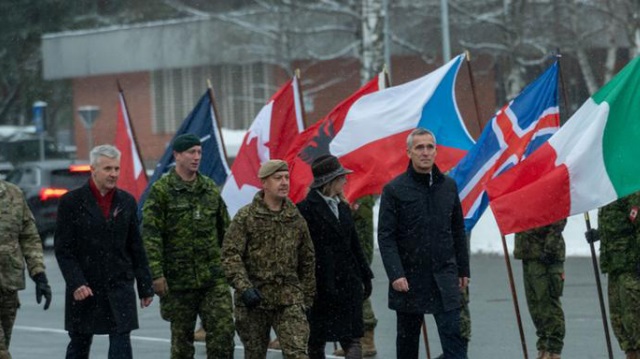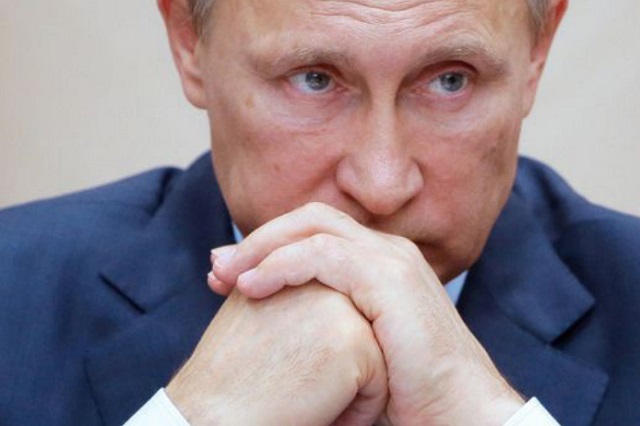
Anticipating the uncertainties that this war will bring is a critical step toward successfully navigating its possible consequences
| THE INDEPENDENT | The invasion of Ukraine by Russian forces has spurred Europe’s worst security crisis in decades. But while most analysis is rightly focused on the immediate situation, it is equally important to forecast the war’s multiple possible trajectories and outcomes. Anticipating the uncertainties that this war will bring is a critical step toward successfully navigating its possible consequences.
Although the situation in Ukraine is fluid, the scenarios outlined here offer four plausible ways in which the conflict might end. Even the rosiest of these possibilities—which we’ve dubbed the “Miracle on the Dnipro”—is fraught with danger. The United States, its transatlantic allies and partners, and indeed the entire world now likely face a difficult period of sustained contestation with Russia.
Scenario 1: Miracle on the Dnipro
Bolstered by defensive assistance from NATO members, Ukraine’s military and civilian resistance overcome the odds and grind Moscow’s advance to a halt, preventing Russian President Vladimir Putin from toppling Kyiv’s democratic government and establishing a puppet regime. The determination and skill of the Ukrainian resistance forces a stalemate on the battlefield that favours the defenders.
Soon, it becomes obvious to the Kremlin that Russia will pay an exorbitant price for its adventurism—including the prospect of a long and costly slog in Ukraine, coupled with economic collapse and diplomatic isolation. Putin sullenly orders a withdrawal of his troops. Ukraine remains a sovereign democracy, while Moscow’s defeat accelerates domestic discontent that has already begun emerging across Russia. Putin turns to focusing on the growing internal threats to his power. Meanwhile, NATO is faced with an improved security situation, as Russia is chastened and Ukraine grows ever closer to the West.
However, the security situation in Europe does not return to the prewar status quo. The short war has claimed thousands of lives on both sides, leaving widespread bitterness in its wake. And although a democratic Ukraine emerges intact if not unscathed, its still-dangerous neighbour faces an uncertain future with the Russian political landscape at a tipping point. Whether the country leans toward greater authoritarianism under Putin, or away from him altogether, will largely determine how Russia behaves with the rest of the world.
 Scenario 2: A quagmire
Scenario 2: A quagmire
After weeks of intense fighting in Kyiv and other major cities, Russia manages to topple Ukraine’s government and install a puppet regime. However, neither Ukraine’s armed forces nor its population are ready to surrender. Far from it: Instead, the Ukrainian population mounts a broad-based, well-armed, and well-coordinated insurgency against the invaders. Although Ukraine’s regular forces are diminished over time, and although major cities such as Kyiv are occupied, Russia’s victory is a pyrrhic one.
Repeating a pattern seen elsewhere in the world, the Ukrainian insurgency forces a significant, sustained human and financial toll on Russia—which is forced to devote far more of its resources over a much longer period of time than it had anticipated. Its headache is compounded by external support for the insurgents, with NATO countries providing covert but very robust defensive assistance to the Ukrainian resistance. The conflict drains Moscow’s coffers and resolve, ultimately forcing a withdrawal after much violence and death.
Putin and senior Russian elites realise they are having their own “Brezhnev moment,” having overreached in their pursuit of maximalist aims in Ukraine. Just as Soviet Premier Leonid Brezhnev led his country’s forces into a long, costly slog in Afghanistan, Russia has once again fought an unwinnable war, the proverbial quagmire that has trapped many powerful states through history. Just as badly, in the eyes of most of the world, Russia has become a pariah state: Ukraine might be devastated, but Putin’s prestige suffers and his domestic position becomes precarious as elites doubt his judgment and the broader populace expresses anger at Russia’s economic situation and reduced global standing.
 Scenario 3: A new Iron Curtain
Scenario 3: A new Iron Curtain
Ukraine eventually collapses under the weight of the Russian invasion. Despite intense opposition, Russian forces manage to take control of the country through the use of increasingly heavy-handed weapons and tactics. Resistance against a Putin-installed puppet government is simmering and omnipresent, but it is put down with brutal force and does not prove strong enough to pose a significant challenge to the substantial Russian forces that remain in Ukraine. A new Iron Curtain descends in Eastern Europe, running along the borders of the Baltic states in the north through those of Poland, Slovakia, Hungary, and Romania in the south.
While Russia faces steep economic costs, Putin solidifies his hold on power internally, quashing domestic dissent even more forcefully. NATO is more united in the face of an emboldened Moscow, but is forced to accept that it has very limited options to reverse the loss of Ukraine. In the wake of the crisis, Sweden and Finland join the Alliance to bolster their security against Moscow’s revanchist designs.
As with the first Iron Curtain, the new schism through the heart of Europe brings with it a familiar list of dangers and uncertainties. Newly suspicious NATO and Russian troops now stare at one another across a suddenly militarised border, once again raising the prospects of direct conflict by accident or design. Intermittent security crises ebb and flow, as Russia repeatedly launches additional military adventures and much more aggressive hybrid warfare operations against NATO allies. The antagonists prepare themselves for a long, bumpy standoff, with no clear outcome and no guarantee of a peaceful resolution.
 Scenario 4: A NATO-Russia war
Scenario 4: A NATO-Russia war
The most dangerous scenario for the future of Europe and the global order is one in which the Ukraine conflict sets the stage for a direct military conflict between NATO and Russia. There are multiple pathways toward such an outcome, including:
- NATO could decide to escalate its involvement in Ukraine by, for example, attempting to implement a no-fly zone or another form of direct intervention. For now, the United States and other NATO allies have rejected implementing a no-fly zone—but that calculus could change if Russia continues to escalate its bombardment of civilians. Russia would be forced to decide whether to back down or directly engage alliance military forces. If it chooses the latter, the risk of an escalating armed conflict between NATO and Russia would increase substantially.
- Russia could inadvertently strike a NATO member’s territory—for example, through imprecise targeting or erroneous identification of friend and foe—prompting countermeasures from the alliance. (Russia already has attacked targets close to the Polish border.) As the Russian military’s stock of precision-guided munitions starts to dwindle, the risk of such an accident leading to an inadvertent escalation with NATO rises. This scenario would see the beginnings of direct conflict, perhaps air-to-air or air-to-ground, in border regions of Ukraine. In turn, this could set off a tit-for-tat cycle of strike and counterstrike leading to open hostilities.
- A fearful prospect concerns the possibility that Putin has broader designs well beyond Ukraine. If Russian forces make rapid progress in Ukraine and achieve effective control over the country, Putin may turn his attention to states that he covets as part of a desire to reconstitute a sphere of influence that broadly aligns with the territory of the former Soviet Union. The obvious candidates to test his designs, and the resolve of NATO itself, would be the Baltic states (all of which are members of the Alliance). Putin might harbor a belief that NATO will back down if pushed; NATO insists it will fight any Russian military incursion on a member state.
The fog of war
Early evidence suggests that this war is turning in the West’s favour for three reasons. The raw aggression of the Russian invasion and the spirited Ukrainian resistance have inspired popular support for Ukraine across Europe. Russia and Putin appear to have badly underestimated both Ukraine’s determination and the global outrage against Moscow. Finally, democratic governments on both sides of the Atlantic have made far-reaching policy choices—economic, financial, diplomatic, and security—that reflect a boldness of purpose and a newfound solidarity.
Yet the world remains in a dangerous and highly uncertain moment. What happens after this conflict is as much a question mark as how, when, and where the fighting ends. These four scenarios reflect plausible outcomes—but they hardly exhaust all possibilities. Putin could end up strengthened or weakened within Russia, depending on domestic developments (a popular uprising or coup) and external ones (China bolstering or reducing its support for Putin himself). He could make a play for Moldova or Georgia, or even attempt to take the Suwalki gap between Russia’s Baltic enclave of Kaliningrad and Belarus.
Wars, once begun, rarely follow a script. More frequently, they lead combatants and non-combatants alike down unanticipated pathways, with occasionally world-changing results. Russia’s invasion of Ukraine appears to have the seeds of such a conflict. What its outcome will mean for Ukraine and the world remains to be seen.
****
This was written by:
- Barry Pavel is senior vice president and director of the Atlantic Council’s Scowcroft Center for Strategy and Security.
- Peter Engelke is deputy director and a senior fellow at the Scowcroft Center for Strategy and Security.
- Jeffrey Cimmino is an associate director of the Scowcroft Strategy Initiative at the Scowcroft Center for Strategy and Security.
Source: The New Atlanticist
 The Independent Uganda: You get the Truth we Pay the Price
The Independent Uganda: You get the Truth we Pay the Price



The war will never end ..There is winner or loser